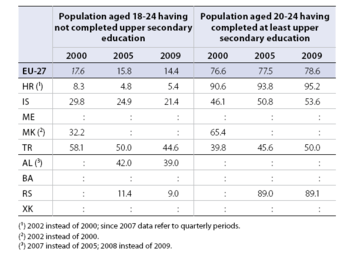Archive:Enlargement countries - education statistics
- Data from Month Year, most recent data: Further Eurostat information, Main tables and Database.
This article presents population-related information and statistics on the education systems in the enlargement countries[1]. It gives an overview of the development of the population, covering the most important indicators i.e.: crude birth rate, crude death rate and fertility rate. It also offers information on major trends at different educational levels in terms of enrolment, education expectancy and graduates.
Eurostat collects statistical information on the demographic conditions and education in candidate and potential candidate countries. These data allow a better understanding of the situation in these countries and allow comparisons with the European Union. These data are also used when the European Commission prepares its annual strategy document detailing its policy on EU enlargement and the progress reports on the political and economic developments in candidate/potential candidate countries.
Main statistical findings

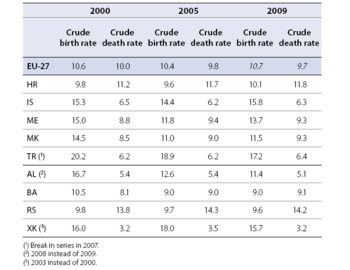
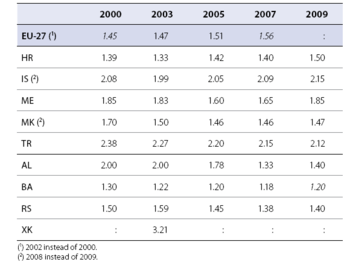

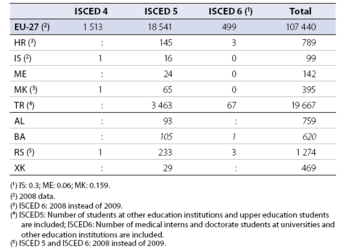
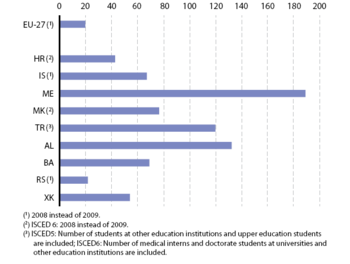
Enlargement of the European Union means that more people join the European “community of values based on peace and freedom, democracy and the rule of law, as well as tolerance and solidarity”. In 2009, almost 500 million people lived in the European Union and around 96 million people in the enlargement countries. The total population of the enlargement countries represent nearly a fifth of the total EU-27 population.
Among the enlargement countries, Turkey has the largest population, with almost 72 million persons, whereas Iceland and Montenegro recorded the lowest numbers, with a population of 319 thousand and 630 thousand respectively, in 2009. The proportion of the different age groups to the total population varied widely among the countries. In the EU-27 and all of the enlargement countries (for which data are available) alike, the working age population (population aged 15-64) accounted for just over two thirds of the total population. Between 2000 and 2009, the working age population increased in the EU-27 and nearly all the enlargement countries, however, in Croatia and Serbia the working age population decreased.
In the EU-27, 15% of the Croatian and Serbian population was aged below 15. With an equivalent share of 25%, the population of Albania and Turkey was much younger. The majority of the enlargement countries saw a decrease in the population below the age of 15. Only in Iceland an increase by just over 2% was registered. Meanwhile, the senior population (64 years of age and over) considerably increased in all countries except Serbia, where the figures fell by almost 5%.
Crude birth rates higher then crude death rates in most enlargement countries
In more than half of the enlargement countries, the crude birth rate is higher than that of the EU-27, which is 10.7 births per 1 000 inhabitants. The highest crude birth rate was recorded in Turkey, Iceland and Kosovo where it reached 17 and 16 births per 1 000 inhabitants respectively in 2009. Croatia and Serbia were the only enlargement countries where the crude death rate was higher than that of the EU-27. The crude rate of natural increase can be calculated by subtracting the crude death rate from the crude birth rate, with a positive result showing that the population is growing (not taking into account the effects of migration). In recent years, Croatia and Serbia were the only countries to record a negative rate of natural increase. Not considering migration, the population in these two countries declined, in Serbia. In contrast, Turkey and Kosovo combine a high crude birth rate and a relatively low crude death rate. As a result, they recorded the largest crude rate of natural increase in 2009 : 12.5 per thousand inhabitants in Kosovo and 10.8 in Turkey.
Fertility rates of over 2 children per woman in Iceland and Turkey
Among the enlargement countries only, Iceland and Turkey recorded fertility rate of over 2 children per woman (according to the latest data available). In Turkey, the rate fell steadily between 2000 and 2009, while in Iceland it rose to 2.15 children per women in 2009, reaching the highest rate in any of the enlargement countries. While the EU-27 and Croatia experienced an upward trend in the fertility rate over recent years, a particularly sharp drop was noticed in Albania, passing from 2.0 in 2000 to 1.33 in 2007, and then to 1.4 in 2009.
Education
Education and training policies are central to the Europe 2020 strategy, aiming at turning the EU into a smart, sustainable and inclusive economy. One of the headline targets of Europe 2020 is to reduce the share of early school leavers to a level of below 10% of the population aged 18-24. Data on educational attainment show that in 2009, close to four fifths (78.6 %) of the EU-27’s population aged 20 to 24 had completed at least an upper secondary level of education. In Croatia and Serbia, this share amounted to 95 % and 89 % respectively, which is a level considerably higher than that of the EU-27. On the opposite, in Iceland and Turkey, barely half of the population aged 20 to 24 had completed at least an upper secondary level of education.
Between 2000 and 2009, the proportion of 18-24 year olds who had not completed upper secondary education and did not participate in any education or training activities has further decreased in the EU-27 and in the enlargement countries for which data are available, i.e. Croatia, Iceland and Turkey. In 2009, the share of early leavers from education and training was a little more than 14 % of the young population. Croatia and Serbia recorded by far the lowest levels in Europe, at under 10%, (below the EU2020 target). In contrast, in both Albania and Turkey early school leavers accounted to 39% and almost 45% respectively (according to the latest data available). A significant gender gap was recorded both in Iceland and Turkey. In 2009, around 25% of men aged 18-24 in Iceland did not complete upper secondary education and was not involved in any education or training, compared with almost 18% of women of the same age. The opposite situation existed in Turkey where around 38% of young men were early school leavers, compared with around 50% of women.
In 2009, the EU-27 counted 107 million pupils and students (from pre-primary to tertiary education). In the enlargement countries, around 24 millions pupils and students were enrolled in the same year. Obviously, the number of pupils depends in various factors, such as the size and structure of the population, the characteristics of the educational system (e.g. the length of compulsory schooling) and the opportunities on the labour market.
One of the objectives of the Europe 2020 strategy is to increase participation in tertiary education. Between 2000 and 2009, the number of students in tertiary education increased in the EU-27 and in all enlargement countries. All enlargement countries recorded higher growth rates than the EU-27 (although they are based on lower absolute values). The percentage of the population aged 20-29 graduating in science and technology increased in the EU-27 as well as in all the enlargement countries in recent years.
Data sources and availability
Data for a core set of indicators is collected each year through questionnaires sent out by Eurostat to the partner countries. A network of contacts in each country has been established for updating the questionnaires. Eurostat distributes the electronic questionnaires to a single contact point in each partner country. This contact point is in charge of the onward distribution of the questionnaires to the various thematic co-ordinators in each country's statistical system (generally within the national Statistical Offices) and of their collection afterwards. When completed, the validated and updated questionnaires are sent back to Eurostat. The only statistical theme extracted from Eurostat’s free dissemination database is demography. Data for Iceland were also extracted from Eurostat’s free dissemination database
Further Eurostat information
Publications
Leaflets
Main tables
- Total population, Candidate countries and potential candidates (tgs00027)
- Gross domestic product, Candidate countries and potential candidates (tgs00028)
Database
Dedicated section
External links
See also
- European cities - demographic challenges
- Population and population change statistics
- Population projections
- Population structure and ageing
- Sustainable development - Demographic changes
Notes
- ↑ This article is based on the pocketbook on the enlargement countries - edition 2011 when Croatia was not yet an acceding country and Serbia was not a candidate country. At present Croatia (HR) is an acceding country, to become a Member State of the European Union (EU) on 1 July 2013 and Serbia was granted candidate country status on 1 March 2012.

